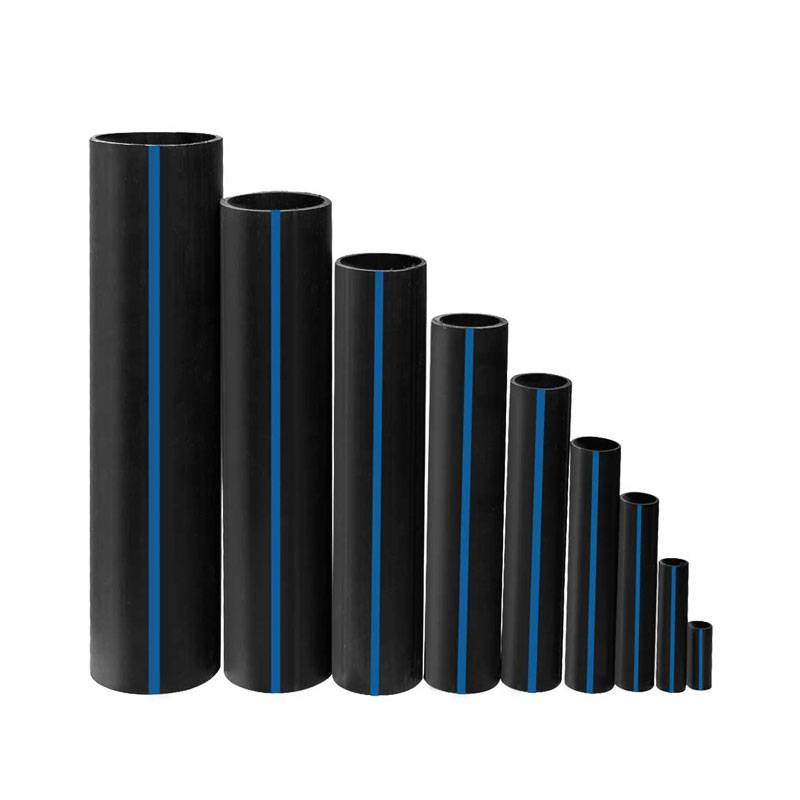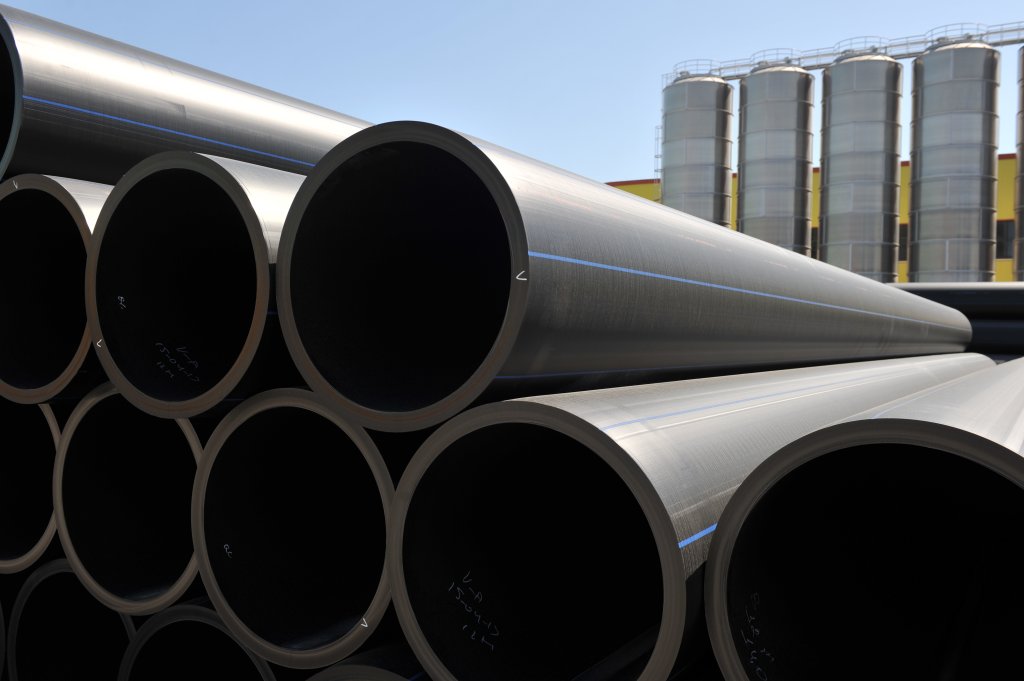How Midland TX HDPE Pipe Fittings in Stock Enable Faster Builds
Wiki Article
Discover the Production Refine Behind High-Quality HDPE Pipe and Its Applications
The manufacturing process of top notch HDPE pipelines is detailed and methodical. It begins with the selection of raw products that boost efficiency. Following this, ethylene undertakes polymerization to create material, which is then formed through extrusion. Quality control is vital, making certain that the end product satisfies strict requirements. The trip of HDPE pipes does not end with manufacturing. Their applications across various sectors expose a broader significance worth checking out.Understanding HDPE: Residences and Advantages

High-density polyethylene (HDPE) is a versatile polycarbonate recognized for its longevity and resistance to numerous ecological factors. This product shows superb tensile strength, making it suitable for requiring applications. Its low-density framework adds to a lightweight product, facilitating convenience of taking care of and installation. HDPE likewise showcases impressive resistance to chemicals, which decreases deterioration when subjected to rough compounds.
The material's reduced moisture absorption better improves its longevity, making it excellent for use in pipes and storage containers. In addition, HDPE is resistant to ultraviolet (UV) radiation, making sure that products preserve their stability also when exposed to sunlight. Furthermore, its adaptability enables the production of elaborate shapes without jeopardizing toughness. The green nature of HDPE, usually acquired from recycled products, includes in its allure, promoting lasting techniques in manufacturing. Overall, these buildings and benefits make HDPE a favored option for various commercial and customer applications.
Raw Material Selection for HDPE Production
The choice of resources for HDPE production is vital to validate the end product satisfies the wanted requirements and quality criteria. High-density polyethylene (HDPE) is primarily produced from polymerized ethylene, originated from fossil gas such as natural gas or unrefined oil. The top quality of these feedstocks significantly affects the mechanical and thermal residential properties of the final HDPE.Ingredients likewise play a considerable duty in improving HDPE's efficiency, including anti-oxidants, UV stabilizers, and colorants, which boost durability and resistance to environmental elements. The choice procedure should consider not just the chemical structure of the raw products however additionally their handling qualities to assure efficient manufacturing.
In addition, the sourcing of resources need to focus on sustainability and compliance with ecological laws, as liable methods are critical in today's market. Inevitably, mindful raw product choice lays the structure for producing high-quality HDPE pipelines suitable for varied applications.
The Extrusion Refine: Shaping HDPE Pipeline
The extrusion procedure plays an essential duty in shaping HDPE pipes, beginning with meticulous material preparation techniques that ensure perfect flow and uniformity. Equally crucial is the design of the die, which directly influences the final dimensions and surface area top quality of the pipeline. Together, these aspects add substantially to the performance and quality of HDPE pipeline manufacturing.Product Preparation Strategies
Effective production of HDPE pipes starts with thorough product prep work techniques, especially the extrusion process. During this phase, high-density polyethylene resin is initial dried out to eliminate moisture, ensuring perfect flow features. The material is after that fed right into the extruder, where it undertakes home heating and melting, transforming right into a thick state. This home heating process is meticulously regulated to preserve the material's integrity and performance. The molten HDPE is required through a die, shaping it right into a continual pipe kind. Appropriate temperature monitoring during extrusion is vital, as it straight impacts the product's buildings and the last item top quality. As soon as shaped, the HDPE pipeline is cooled and reduced to defined lengths, all set for subsequent handling and applications.Die Layout Value
Accuracy in die style plays an essential duty in the extrusion procedure of HDPE pipes. The die offers as the last shaping device, directly affecting the pipeline's measurements, wall surface density, and surface finish. A properly designed die guarantees uniform material flow, reducing problems such as irregularities and weak places. The geometry of the die should be optimized to fit the particular buildings of HDPE, including its thickness and thermal behavior throughout extrusion. Furthermore, the cooling rate of the product as it passes with the die can significantly affect the pipe's structural integrity. Investing in advanced die technology is vital for makers intending to create high-grade HDPE pipelines that satisfy industry standards and consumer expectations.Quality Assurance Procedures in HDPE Production
Although various factors influence the top quality of HDPE pipe production, effective quality assurance measures are important to guarantee consistency and reliability in the final item. Trick quality control techniques include strenuous product evaluation, verifying that the raw polyethylene fulfills established criteria for purity and thickness. During the extrusion procedure, specifications such as temperature, pressure, and sanitary pipe fittings cooling time are very closely checked to preserve dimensional accuracy and architectural honestyIn addition, post-production screening is important; suppliers frequently carry out hydrostatic examinations to analyze the pipeline's toughness and resistance to pressure. Aesthetic assessments for surface area problems better boost top quality assurance. Qualification from appropriate standards companies, like ASTM or ISO, gives an additional layer of reliability. By executing these comprehensive high quality control steps, manufacturers can decrease problems, improve performance, and ensure that the HDPE pipelines satisfy the specific demands of numerous applications, eventually leading to consumer satisfaction and trust fund in the item.
Applications of HDPE Pipeline Across Industries
HDPE pipelines are utilized across different industries due to their sturdiness and flexibility. In water distribution systems, they ensure reliable delivery, while in wastewater administration, they provide reputable options for waste transport. Furthermore, farming irrigation networks take advantage of HDPE's resistance to corrosion and flexibility, making it an ideal choice for contemporary farming practices.
Water Circulation Equipments
A significant number of markets depend on high-density polyethylene (HDPE) pipes for efficient water circulation systems. Recognized for their durability and resistance to corrosion, HDPE pipes are commonly utilized in community water networks, farming watering, and industrial applications. Their light-weight nature facilitates simple handling and installation, reducing labor costs and time. In addition, HDPE pipelines can suit different stress degrees, making them suitable for both low and high-pressure systems. Midland TX HDPE Pipe Fittings in Stock. The adaptability of the material permits seamless integration right into existing infrastructure, minimizing the need for substantial excavation. Furthermore, HDPE's resistance to chemical leaching assurances that the water provided remains risk-free and clean, making it an ideal selection for keeping the quality of safe and clean water across numerous fieldsWastewater Administration Solutions
Efficient water distribution systems likewise lead the way for ingenious wastewater administration solutions, where high-density polyethylene (HDPE) pipes play a considerable function. Popular for their longevity and resistance to deterioration, HDPE pipelines are ideal for transferring wastewater in different setups. Their versatility permits easy installation in complicated atmospheres, lessening the need for comprehensive excavation. Furthermore, HDPE's smooth interior surface minimizes rubbing, improving circulation prices and effectiveness. These pipelines are also resistant to chemical leaching, making sure that impurities do not jeopardize the surrounding setting. Industries, towns, and treatment facilities significantly depend on HDPE pipelines for their dependability and long life, making them a recommended selection for modern wastewater management systems. This adaptability underscores the essential value of HDPE pipes across countless applications.Agricultural Irrigation Networks
Agricultural irrigation networks benefit considerably from the use of high-density polyethylene (HDPE) pipes, which provide effective and trustworthy water distribution to plants. HDPE pipelines are lightweight, making them easy to carry and mount, while their versatility enables numerous arrangements in varied terrains. These pipes show exceptional resistance to corrosion, chemicals, and UV radiation, guaranteeing toughness in harsh farming atmospheres. Furthermore, their smooth indoor surface area reduces rubbing loss, maximizing water flow and minimizing energy prices associated with pumping. The longevity of HDPE pipes, commonly surpassing half a century, adds to lower upkeep and substitute expenses. As browse around this web-site a result, farmers significantly rely upon HDPE pipelines to boost watering performance and advertise sustainable agricultural practices, ultimately resulting in boosted plant yields and resource preservation.Future Patterns in HDPE Pipe Modern Technology
As the demand for sustainable and efficient facilities expands, improvements in HDPE pipeline innovation are poised to change different sectors. Arising fads include the assimilation of smart innovations, such as sensors and IoT abilities, which facilitate real-time tracking of pipe problems, minimizing maintenance costs and stopping leakages. Additionally, the development of sophisticated manufacturing techniques, such as 3D printing, is enabling the manufacturing of complicated, customized pipe layouts that accommodate certain project needs.Furthermore, the emphasis on recycling and circular economic situation practices is driving the advancement of HDPE pipelines made from recycled products, enhancing sustainability. Enhanced jointing techniques, such as electro-fusion and mechanical fittings, are likewise enhancing setup effectiveness and dependability. Ultimately, the growing focus on ecological policies is pushing producers to embrace greener production procedures, ensuring that HDPE pipelines not just satisfy market criteria yet also foster a more lasting future for infrastructure advancement.
Frequently Asked Inquiries
Exactly How Does HDPE Compare to Other Plastic Materials?
HDPE exceeds many various other plastic materials concerning durability, chemical resistance, and flexibility. Its reduced density and high tensile strength make it optimal for numerous applications, often exceeding choices in both performance and durability.What Are the Ecological Influences of HDPE Manufacturing?
The environmental impacts of this HDPE manufacturing include greenhouse gas exhausts, energy consumption, and possible pollution from making procedures. Furthermore, improper disposal can result in soil and water contamination, elevating problems regarding long-lasting eco-friendly results.Can HDPE Water Lines Be Recycled?
Yes, HDPE pipes can be reused. Several facilities approve utilized HDPE for handling, transforming it into new items. This recycling contributes to sustainability initiatives, reducing plastic waste while saving sources and energy in the production cycle.What Is the Life Expectancy of HDPE Pipeline?

How Do Temperature Level Variants Influence HDPE Pipe Performance?
Temperature level variations significantly affect HDPE pipeline efficiency, affecting flexibility and stamina. High temperatures can cause softening, while low temperatures may cause brittleness, eventually affecting the pipe's resilience and suitability for numerous applications in diverse settings.Report this wiki page